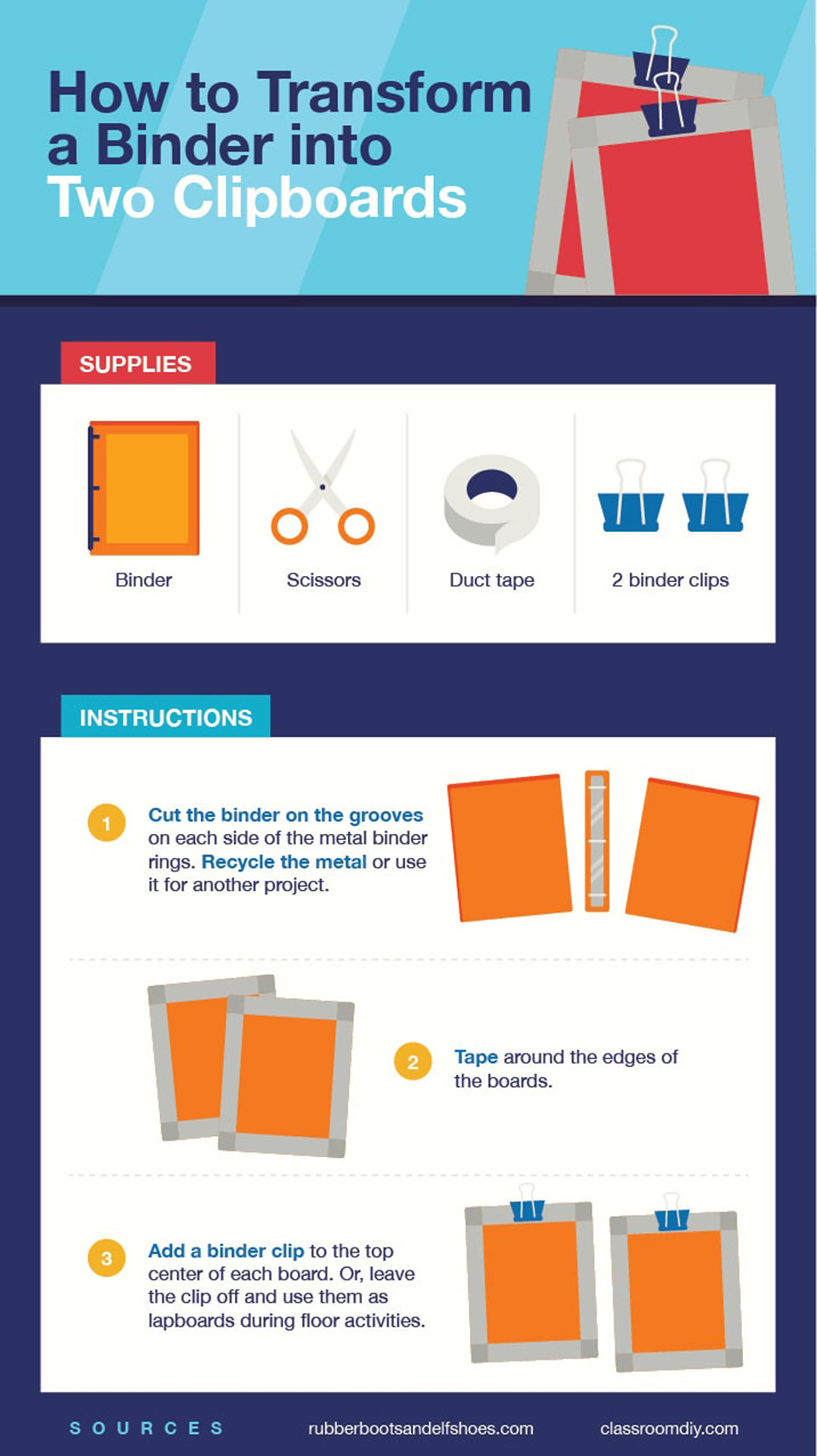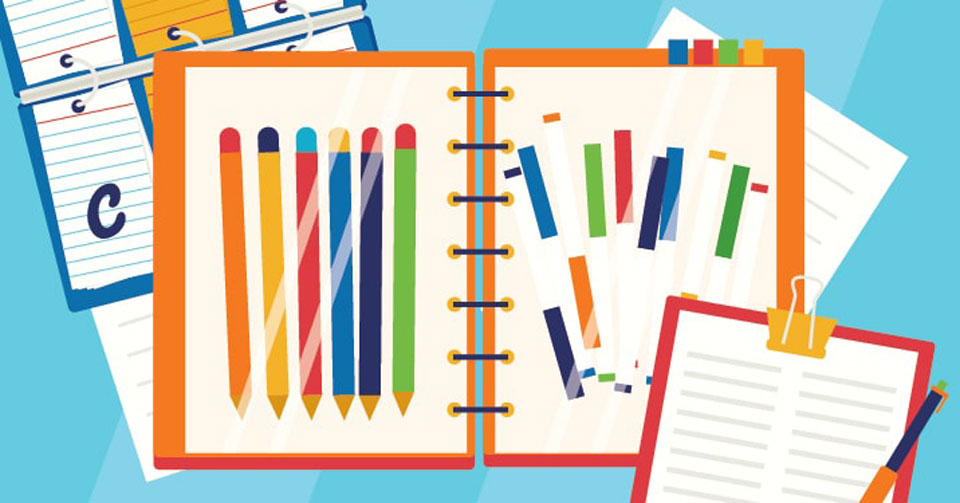Teachers juggle exhausting schedules, mountains of paperwork, and piles of supplies. It's no wonder so many of them feel overwhelmed and disorganized. Unfortunately, the work is here to stay, but a simple tool can help you find more order: the three-ring binder. This classic device, first patented in Germany in 1886, can help you organize your classroom, connect with your students, and provide a richer and more active learning experience. Read on to learn seven creative ways binders can improve your classroom.

1. Student Portfolios
Do your students take time to evaluate, organize, or reflect on the work they do in your classroom? If not, they could be missing out on a powerful and authentic learning opportunity, not to mention a handy way to hang on to their best work and share it with parents, future teachers, and scholarship or college admissions committees. Research suggests student portfolios are beneficial because they involve students in research, writing, problem-solving, and assessment.
Here's how to help students make meaningful student portfolios.
- Determine the primary goal for the project. It could be to:
- Display a student's best work
- Display a student's learning progress
- Display evidence that learning standards were met
- Help students reflect on their work
- Provide students with keepsakes from the year
- Decide on the primary audience for the project. It could be:
- The student
- The teacher (either the current teacher or the student's next teacher)
- Parents
- An administrator
- A scholarship or college admissions committee
- Let students help plan and make their portfolio.
- Supply students with two binders, one for the portfolio and one as a working binder, where students keep materials to be evaluated for inclusion in the portfolio.
- Collect, date, and store work samples for a specified period, either a term, semester, or year.
- Choose regular intervals to evaluate work for inclusion in the portfolio.
- Encourage students to routinely evaluate and improve their portfolios by asking questions such as:
- Have I shown a variety of work?
- Does the work I've chosen show how I've improved?
- Does the work I've chosen reflect my interests?
- Does the work show where I've come from and where I'm going?
2. Student Profile Binder
Effective classroom management relies on forming positive relationships with individual students. But it's challenging to get to know each student personally in a crowded classroom. A student profile binder can help. Designate a binder for each class, and make a tab for each student. File information there such as:
- A completed information sheet about a student's family, pets, and interests
- An “all-about-me” essay
- A completed learning styles inventory
- Individual Education Program (IEP) goals and notes
Review a student's information whenever needed and before a parent conference or IEP meeting to help you understand the student's background, needs, and concerns. This practice helps teachers build individual relationships based on trust and respect, which makes managing the classroom easier.
3. Substitute Teacher Binder
Preparing for a sub is no easy task, and it too often needs to be done at the beginning or end of an already long day. Get a head start by making a substitute teacher binder to store up-to-date information your subs may need. As an added bonus, subs will love you. It's challenging to stand in for a teacher. With a fully loaded binder, substitutes won't need to search for information about your school, students, or procedures.
Consider including the following:
- A welcome page introducing yourself and your classroom
- Phone numbers for the office, nurse, and special education room
- Names of teachers and students who can answer questions when needed
- Explanation of your daily procedures
- Class rosters
- Seating charts
- Directions for using technology, such as a projector, smart board, or document reader
- Explanation of your classroom management practices
- Forms or hall passes
- List of students who need to leave the classroom for support classes or who have health issues that may need to be addressed
- Emergency lesson plans in case you're unable to prepare customized plans
- Filler activities in case the class completes assignments early
- Map of the school with important rooms highlighted
- The school's emergency evacuation procedures
- A feedback form for the sub to leave notes for you
4. Phonics Flip Books
Primary teachers or reading specialists can transform a binder into a fun tool to help beginning readers learn to sound out words.

5. Puzzle Organizers
Primary school teachers are often inundated with stacks of puzzles in tattered cardboard boxes. Downsize the clutter by transforming binders into handy puzzle organizers.
Supplies:
- 3-ring binder
- Gallon–size slide–lock freezer bags
- Duct tape
- 3–hole punch
- Labels
- Marker
Instructions:
- Line the bottom two inches of the bags with duct tape on the front and the back.
- Make sure the hole punch is set to the North American 3–hole standard, with the center of the holes 4.25 inches apart. Then use it to punch holes in the tape at the bottom of the bag.
- Label the bag with a description of the puzzle or game it contains.
- Insert the puzzle pieces into the bag.
- File the plastic bag in the binder.
- Repeat with the rest of your puzzles
- Use the same method to contain and organize games, magnets, and other props
6. Mobile Art Stations
Tired of storing and moving around buckets of crayons, colored pencils, and other art supplies? Transform binders into mobile art stations. Use the same method as above to make pockets out of plastic bags. Place a bag of crayons, colored pencils, and markers in each binder, as well as a bag containing a pair of scissors, a glue stick, two pencils, and an eraser. At the end of the binder, include coloring sheets, word searches, crosswords, and blank paper. Mobile art stations fit neatly on shelves, and students can grab one during choice time or after they've completed all of their other tasks.
7. DIY Clipboards
Physical activity shouldn't be confined to P.E. and recess. Getting kids up and moving around during regular lessons is also important and beneficial. In one study, 13.5 percent more students reached their goal on the state standardized test after physical activity was incorporated into regular lessons. But how do kids work when they're on their feet? Transform binders into clipboards that can be used as mobile workstations. Students can make and personalize clipboards, and bring them along on nature studies and hands–on learning activities. Bonus: The project can double as a lesson about recycling materials.

Conclusion
While binders were invented more than a century ago, they're still as useful and versatile as ever. Put them to work to make your classroom a more effective, organized, and active learning environment.

Share this infographic on your site
Abby Quillen
Abby Quillen is the author of the novel The Garden of Dead Dreams and the editor of two anthologies. Her articles and essays have appeared in YES! Magazine and The Christian Science Monitor and on Common Dreams, Nation of Change, Reader Supported News, The Daily Good, Truthout, and Shareable. She lives in Eugene, Oregon, with her family. When she's not writing, she grows vegetables and weeds, bikes and walks as much as she can, and jots down cute things her kids say.

